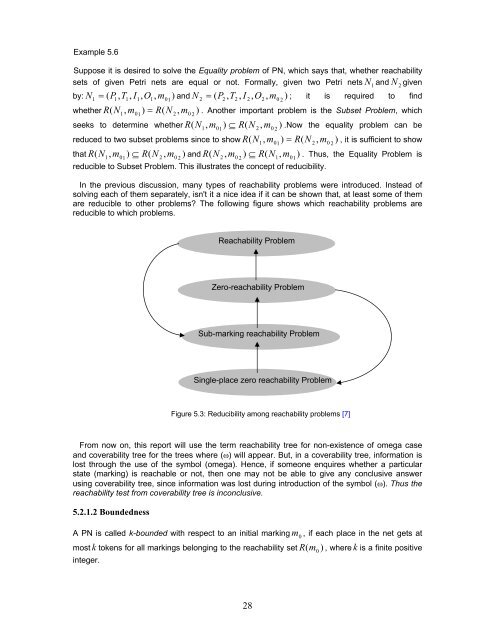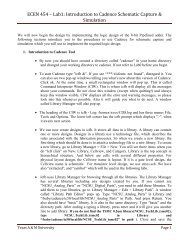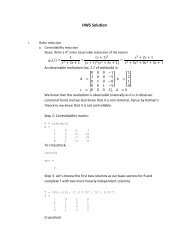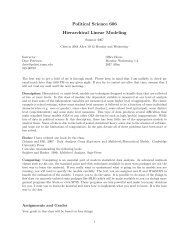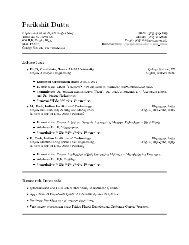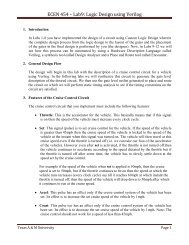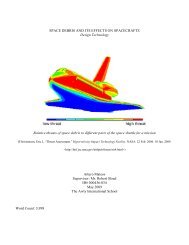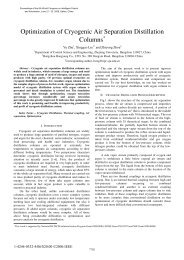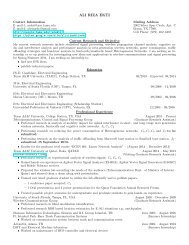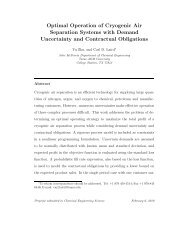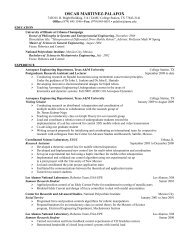A Study of Petri Nets: Modeling, Analysis and Simulation - Tamu.edu
A Study of Petri Nets: Modeling, Analysis and Simulation - Tamu.edu
A Study of Petri Nets: Modeling, Analysis and Simulation - Tamu.edu
You also want an ePaper? Increase the reach of your titles
YUMPU automatically turns print PDFs into web optimized ePapers that Google loves.
Example 5.6<br />
Suppose it is desired to solve the Equality problem <strong>of</strong> PN, which says that, whether reachability<br />
sets <strong>of</strong> given <strong>Petri</strong> nets are equal or not. Formally, given two <strong>Petri</strong> nets N1<br />
<strong>and</strong> N<br />
2<br />
given<br />
by: N<br />
1<br />
= ( P1<br />
, T1<br />
, I1,<br />
O1<br />
, m0<br />
) <strong>and</strong> N ( , , , , )<br />
1<br />
2<br />
= P2<br />
T2<br />
I<br />
2<br />
O2<br />
m0<br />
; it is required to find<br />
2<br />
whether R ( N1,<br />
m ) = R(<br />
N<br />
2,<br />
m0<br />
) . Another important problem is the Subset Problem, which<br />
01<br />
2<br />
seeks to determine whether R( N1,<br />
m ) ⊆ R(<br />
N<br />
2,<br />
m0<br />
) .Now the equality problem can be<br />
01<br />
2<br />
r<strong>edu</strong>ced to two subset problems since to show R ( N1,<br />
m ) = R(<br />
N<br />
2,<br />
m0<br />
) , it is sufficient to show<br />
01<br />
2<br />
that R( N1,<br />
m ) ⊆ R(<br />
N<br />
2<br />
, m0<br />
) <strong>and</strong> R( N , ) ( , )<br />
01<br />
2<br />
2<br />
m0 ⊆ R N<br />
2<br />
1<br />
m0<br />
. Thus, the Equality Problem is<br />
1<br />
r<strong>edu</strong>cible to Subset Problem. This illustrates the concept <strong>of</strong> r<strong>edu</strong>cibility.<br />
In the previous discussion, many types <strong>of</strong> reachability problems were introduced. Instead <strong>of</strong><br />
solving each <strong>of</strong> them separately, isn't it a nice idea if it can be shown that, at least some <strong>of</strong> them<br />
are r<strong>edu</strong>cible to other problems? The following figure shows which reachability problems are<br />
r<strong>edu</strong>cible to which problems.<br />
Reachability Problem<br />
Zero-reachability Problem<br />
Sub-marking reachability Problem<br />
Single-place zero reachability Problem<br />
Figure 5.3: R<strong>edu</strong>cibility among reachability problems [7]<br />
From now on, this report will use the term reachability tree for non-existence <strong>of</strong> omega case<br />
<strong>and</strong> coverability tree for the trees where (ω) will appear. But, in a coverability tree, information is<br />
lost through the use <strong>of</strong> the symbol (omega). Hence, if someone enquires whether a particular<br />
state (marking) is reachable or not, then one may not be able to give any conclusive answer<br />
using coverability tree, since information was lost during introduction <strong>of</strong> the symbol (ω). Thus the<br />
reachability test from coverability tree is inconclusive.<br />
5.2.1.2 Boundedness<br />
A PN is called k-bounded with respect to an initial marking m 0<br />
, if each place in the net gets at<br />
most k tokens for all markings belonging to the reachability set R ( m0<br />
) , where k is a finite positive<br />
integer.<br />
28


